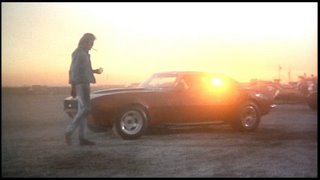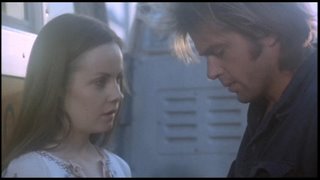
ALOHA BOBBY & ROSE (1975, directed by Floyd Mutrux, 88 minutes, U.S.)
Most serious film buffs have a mental list of a handful of pet films that they pester friends to see. Something forgotten, rare or offbeat that symbolizes an unjust world that fails to appreciate true beauty and genius. Asked to curate a film to send West Philadelphia’s Cinemagic off into the movie theater netherworld, I avoided thinking of relevance, drawing power or historical importance. Instead I went with my gut reaction, thinking I’d love to see Floyd Mutrux’s 1975 lovers-on-the-run tale ALOHA BOBBY & ROSE with an audience again.
ALOHA is a primo portrait of 1970’s existential aimlessness disguised as a drive-in movie and is audaciously shot by William Fraker, one of the truly gifted cinematographers of the era. With renewed interest in 70’s cult items like BRING ME THE HEAD OF ALFREDO GARCIA and TWO LANE BLACKTOP (on which Mutrux did some uncredited writing), ALOHA BOBBY & ROSE seems ripe for rediscovery.
ALOHA is the second film in director Mutrux’s small but distinctive filmography, a companion piece to his stunning debut DUSTY & SWEETS MAGEE. Shot in 1970, DUSTY followed a group of unconnected heroin users around the fringes of L.A. With the glamorous sheen of Los Angeles being the neutral setting of so much of Hollywood film and television, DUSTY stands in contrast as one of the rare films to reveal the skuzzy sun-bleached underbelly of the city. DUSTY is part documentary and part staged drama, where mostly non-professional actors deliver their zonked-out philosophies directly to the camera, then take us back to their rooms to watch them shoot-up and lie around.
ALOHA takes us back to the same low-rent L.A. setting to show us around with just a smidgen of incident propelling us through its star-crossed lover scenario. Bobby is a completely unambitious auto mechanic with a souped-up ’67 Camero. When his co-worker Moxey (the gangly younger Carradine brother, Robert) shows enough initiative to apply to transmission school, Bobby derides such blatant careerism. Who wants to wake up that early? Bobby is played by Paul LeMat, fresh of his tough guy role as John Milner in AMERICAN GRAFFITI. LeMat’s Bobby could be the same character, his ducktail grown out into a shag and his natural geniality starting to sour with his new awareness that all this hot-rodding isn’t leading anywhere.

Diane Hull plays Rose, a single mother whose life seems so stifled her boozy mom encourages her to kick loose and go out with Bobby when he delivers her car from the garage. While on their date a dumb prank spirals out of control (leading to cinema’s freakiest car crash) and the two set off for Mexico in an attempt to escape the law.
The 1970’s were the last time that popular films would be so casually fatalistic. Much like DeNiro’s Johnny Boy in MEAN STREETS (a film ALOHA echoes with its rock score and improvised feel), Bobby is a character that seems less likely to survive the film the more we get to know him. Apparently nearly broke throughout the entire film, Bobby seems to have no support, dreams or prospects. He’s more feckless than self-destructive but his indifference seems so profound you can’t imagine the future having a place for this guy. The “Aloha” of the title is a reference to a passing thought running off to Hawaii, a dream Bobby and Rose seem to choose because of its very improbability.

When Bobby first meets Rose he lays it on thick trying to impress her but his lies are as transparent as a child’s. She finally calls him on his bluster and Bobby seems to wilt into her arms, “When you work in a gas station, you gotta bullshit” he meekly admits, and with that admission he seems to win Rose’s sympathy and love, that brand of instant-love that frequently strikes in Hollywood. Diane Hull makes the under-written script appear poetic. She was another of the open hearted long-haired hippy gals of the seventies, like Cheryl Rainbeaux Smith or Christina Raines, who worked steadily for a time then seemed to disappear.
But the real star of this film is cinematographer William Fraker. The former President of the American Society of Cinematographers, Fraker shot some of the iconic films of the sixties and seventies, including ROSEMARY’S BABY and BULLITT. In ALOHA he seems to have been given a free hand to shoot some of his boldest work (Mutrux used him on every one of his films) and Fraker delivers a pictorial essay of L.A. at night. Fraker’s work often features rich colors cutting through the darkness and as the bruised and bleeding lovers move through the city his images give the sensation that Bobby & Rose are merely insignificant pinballs bouncing amidst the bumpers of a shimmering pinball machine.

In one unforgettable scene the two drive down Hollywood boulevard and the camera shows us, shot from below, the giant music billboards that line both sides of the street. While the DJ motormouths an into to Junior Walker’s “What Does It Take To Win Your Love” Bobby & Rose are little people dwarfed by giant-sized effigies of Ringo Starr, The Stones, Marvin Gaye and Al Green. There a real excitement to the way the music and the images come together but there also the feeling that you could never be a bigger nobody in life than right here, cruising below the shadows of these God-like entertainers.
As Bobby and Rose escape towards the Mexican border they end up briefly riding with another couple, Buford and Donna Sue. Played by Tim McIntire (who had a mesmerizing turn playing rock and roll pioneer Alan Freed in Mutrux’s following film AMERICAN HOT WAX) and Leigh French (of the San Francisco improv comedy group The Committee), this duo seems to epitomize the American Dream to Bobby. Buford wears a cowboy hat, owns a Cadillac with a phone in the back and, along with the chirpy Donna Sue, seems to just drive around and raise hell wherever he goes. Although we can see the Buford is as full of bullshit as Bobby, he at least has some spirit in him and Bobby seems to shrink in his presence, merely becoming a sidekick in his own film. Rose barely tries to play along, quietly distressed at Bobby’s boyish admiration for this insufferable blowhard.
But there’s no future in being this guy’s lackey and with no real place to run Bobby and Rose have no choice but to turn around and meet their fate. At 88 minutes, ALOHA plays like an American BREATHLESS, succeeding at what American films do best: taking a pulpy and recognizable genre and revving it up with an individualistic personal vision. Now, thirty-one years later, ALOHA’s period stylizations have mellowed beautifully, turning what may have seemed tossed-off and minor youth film into a dreamy, blissed-out and tragic reverie.

*There will be a free screening of ALOHA BOBBY & ROSE Sunday September 24th 2006 at 4:00pm at the final day of screenings at the Cinemagic Theater (3925 Walnut Street, Philadelphia PA). ALOHA BOBBY & ROSE will be projected from DVD.

2 Comments:
Although the 1970’s were my declining years, I was still alive then and I can tell you that existential aimlessness was the order of the day. Nice choice for cinemagic. And now it is with a withered ticker full of gladness that I bare it toward the LCD glow of your forthcoming dispatches.
great post dan - anyone who has the same layout as my blog is obviously a good spirit! hope all is well in your world :)
Post a Comment
<< Home